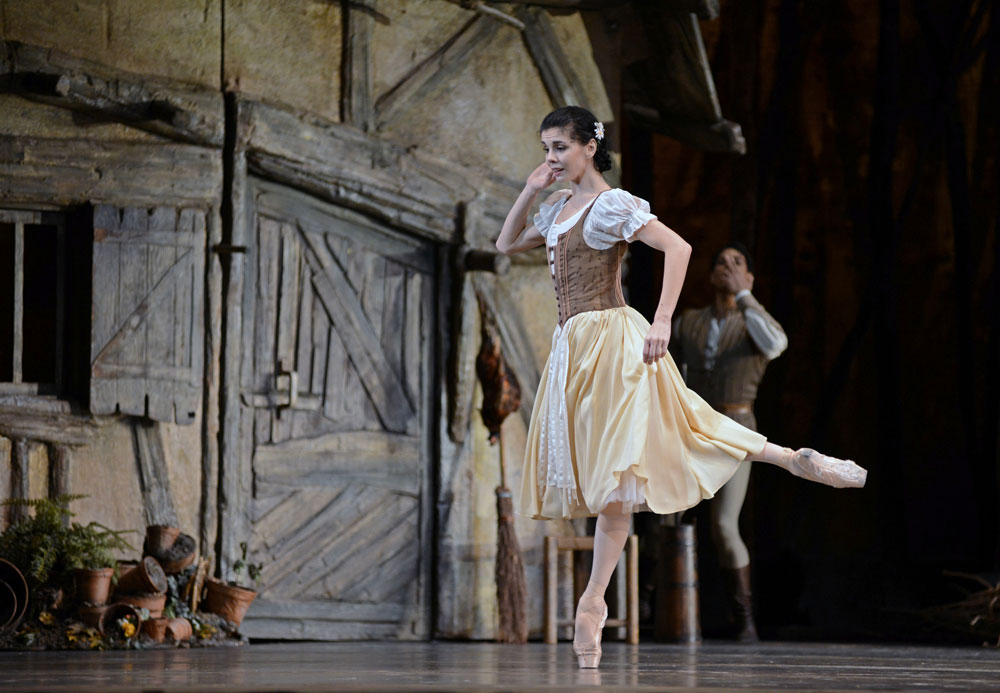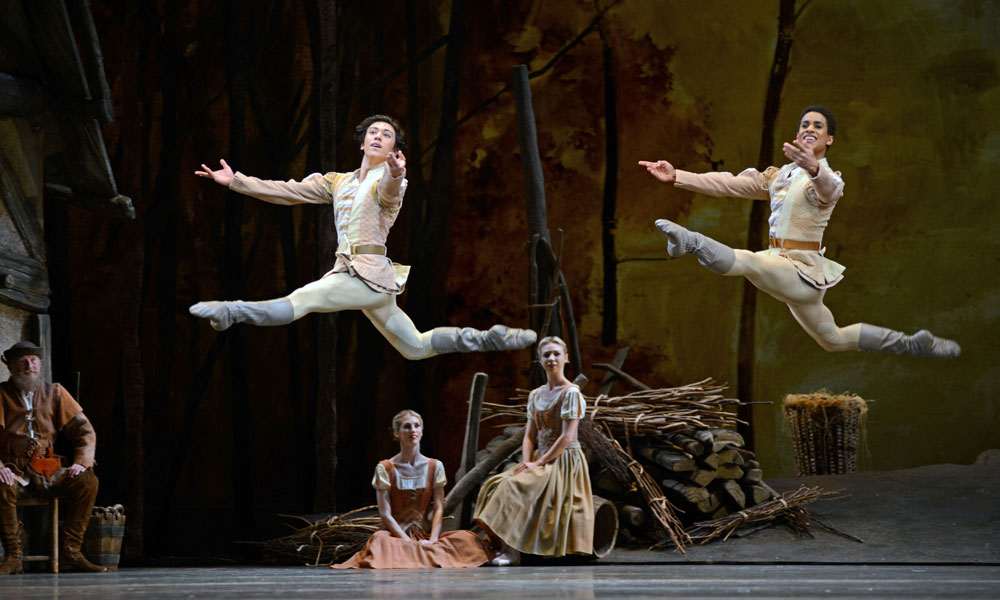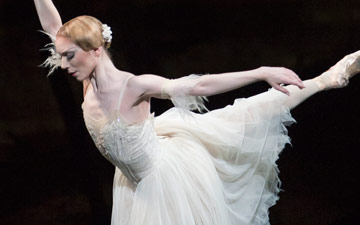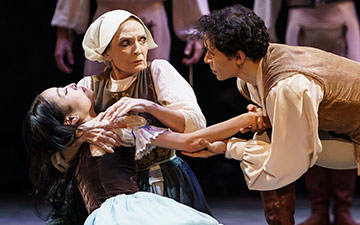
© Dave Morgan, courtesy the Royal Opera House. (Click image for larger version)
The Royal Ballet
Giselle
London, Royal Opera House
18 January 2014
Gallery of pictures by Dave Morgan
www.roh.org.uk
It looks as though Natalia Osipova is to become Sylvie Guillem’s successor at the Royal Ballet, giving her idiosyncratic interpretation of a role whether or not it aligns with the company’s existing production. The result can be both stimulating and disconcerting.
Peter Wright’s 1985 production of Giselle places the heroine firmly at the heart of village life in Act I. She is, in theory, little different from the local girls (wearing the same sort of peasant dress) except in her passion for dancing. Osipova, vivid and shy, is outstanding from the moment she takes to the air in Giselle’s signature ballonnés. She is, nonetheless, convincing as a rural village maiden, overawed at first by her fine-mannered suitor, Loys/Albrecht, as indeed she will prove to be by the noble hunting party. She is well aware of her humble social status.

© Dave Morgan, courtesy the Royal Opera House. (Click image for larger version)
Osipova’s Giselle is uncertain enough of her lover’s ardour for her to take the flower test seriously – ‘he loves me not’. She evidently hasn’t told her mother about him, and she’s bluffing when she claims to Bathilde (and her mother, Berthe) that she’s engaged to him. Osipova has thought through every nuance, including the heart condition that Giselle is trying to minimise. No wonder Deirdre Chapman’s Berthe is so stern: she’s had to nurture a febrile, damaged daughter who lives to dance.
When Osipova mimes the ‘dance’ gesture, revolving her hands high above her head, vitality sparks from her fingers. When Bathilde – Christina Arestis, supremely condescending – invites Giselle to show off her prowess, Osipova revels in the chance to rejoice in what she does best. Seemingly artless, she sails through the solo, until her flurry of piqué turns at the end implies that she’s hyper-excited. This Giselle is in a precarious state, even before she realises she’s been betrayed.

© Dave Morgan, courtesy the Royal Opera House. (Click image for larger version)
Her mad scene is in character, but in the context of Wright’s naturalistic production, it comes across as histrionic. Too much hair, too much flailing and falling. As if embarrassed, the villagers leave her alone with mother at the end of Act I, inapppropriately like Lady Capulet with Tybalt’s corpse. Albrecht has become too involved: his loyal squire Wilfred should swiftly whisk him away from trouble.
Johannes Stepanek has been a correct courtier up to this point, properly advising Carlos Acosta’s Albrecht against an unsuitable dalliance. Acosta’s Albrecht is very much an aristocrat, pretending to learn peasants’ ways of carousing. He is a noble man in every way, sincerely expressing his remorse in Act II. What Acosta now lacks in stamina, he makes up for in presence (and multiple pirouettes). Thomas Whitehead as Hilarion stands up to him manfully.

© Dave Morgan, courtesy the Royal Opera House. (Click image for larger version)
Act II becomes problematic because Osipova is so much more daemonic than dominatrix Myrtha (Hikaru Kobayashi). Once Osipova is summonsed to assume Giselle’s spectral fate as a Wili, she is overtaken by an unseen force. However much she wants to protect repentant Albrecht, her legs and feet tug her away from him. Her phenomenal elevation means that she can accomplish the Cecchetti assemblés and soubresauts (with both knees bent before landing) that few Giselles can manage. She does not, however, appear ethereal – especially in a low-cut, sleeveless costume that exposes her athletic shoulders.The demure outline of a Romantic ballerina with long drooping neck is not for her.

© Dave Morgan, courtesy the Royal Opera House. (Click image for larger version)
So, like Guillem, she gives us a modern Giselle, at odds with Wright’s corps of obedient Wilis. The battle to save Albrecht is not between her and Myrtha but between the dual aspects of her nature as vengeful siren and love-struck innocent. The tussle can look tortuous, even ugly: Osipova’s arms and large hands don’t display the finesse of a Royal Ballet port de bras. Yet her Act II is compelling in its intensity, her leave-taking of Albrecht heartbreaking. She is a rare artist – but still more of a guest artist than a company ballerina.

















With all due respect to Natalia Osipova’s undeniable gifts, I personally find the comparison between her and Sylvie Guillem unfortunate. I think Osipova has still a long way to go before she succeeds anyone, whether that would be Guillem, Cojocaru, Rojo or other dancers. Each dancer paves his or her own way not only with their talent but also because of their choices.
Guillem is in a league of her own. Like Baryshnikov (who has done this for male dancers) she has litterally reshaped forever the image of ballerina not only with her extraordinary physique, but also with her risky venturing into both classical and modern repertory. When Guillem was still at the Paris Opera House she was doing one night “Raymonda” and then the revolutionnary “In the middle somewhere elevated” by Forsythe. And she has kept doing that for around thirty years or so now. Even recently she was in Athens doing “Sacred Monsters” with A. Khan and then right after “Marguerite et Armand” with Massimo Murru. So the choices an artist makes are just as important and I fail to see this venturing in Miss Osipova’s career yet, not to speak about her portrayals. It is a shame that critics rarely travel abroad to see Guillem performing (besides Marguerite she portrayed Mats Ek’s “Carmen” in Japan and not so long ago, she was doing an extraordinay “Steptext” by Forsythe in Florence, a choreography she has not danced since around 1995-96.
What mostly matters with Guillem, is that here you have a dancer who is a role model for most top ballerinas around the world (Vishneva, Rojo, Cojocaru, Zakharova etc) as well as most aspiring young dancers. The range of her repertory is unsurpassed (the classics, plus the great neoclassical ballets like “Manon”, or “Marguerute”, “Romeo and Juliet). She has also inspired the great contemporary choreographers who have especially choregraped for her (Bejart, Forsythe, Mats Ek). And she continues this research with the new generation of talented choregraphes like Maliphant or A. Khan. The bottom line is not that Guillem is “modern” let us say in her portrayal of Giselle or not. She uses her classical training in a creative manner when she dances a classical part and she also uses that training in a most creative way when she does modern choreographies. It is hard to think of anyone, with the possible exception of Baryshnikov who has had such scope, such range, or such a rich career.
Best regards, Nakis
I don’t think Jann Parry is really comparing Osipova and Guillem at all – just noting that both do their own thing when dancing with the Royal Ballet. And that was it. Love Guillem but I don’t think anybody was looking to sell her short here.